Fishing Streamers Is Still All About Presentation
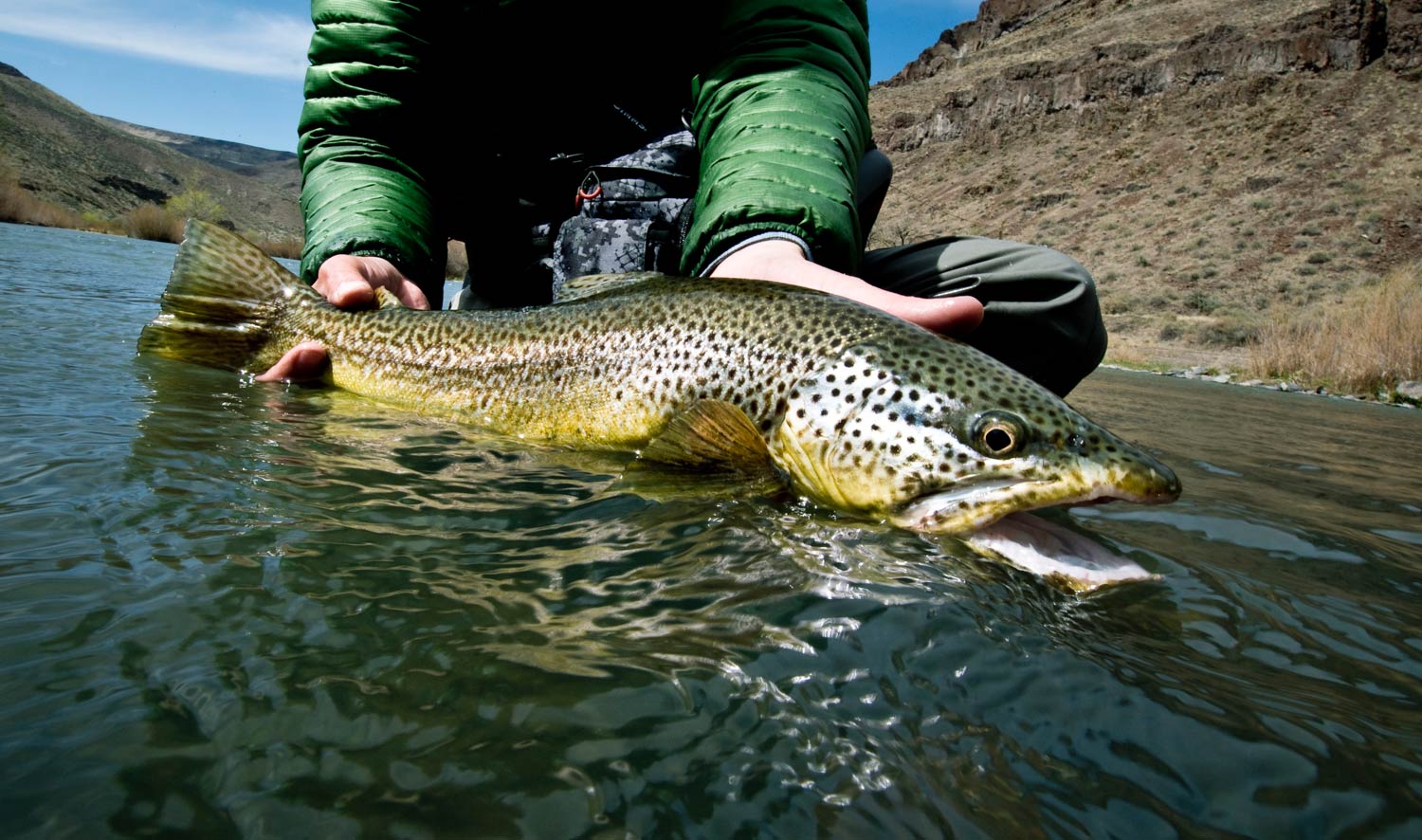
STREAMER JUNKIES, AND I INCLUDE MYSELF, GET A BAD RAP FROM THE DRY FLY CROWD.
In some places they even go so far as to call them lures, rather than streamers. The dyed-in-the-wool purest would portray those of us with the nerve to fish a four- or six-inch fly as neanderthals. The mantra of the dry fly purest is this.
“Imitation and presentation, that’s fly fishing.”
When I hear those words, I think to myself, “Is there a better description of streamer fishing?”
That’s what we’re doing, isn’t it? Imitating a type of forage food and presenting that Imitation in a manner that makes it believable. The fact that the forage food we have chosen is not an insect makes it no less artful. If your streamer is not presented in a way which the fish can appreciate, it’s still not going in the mouth.
I was reminded of this the other day when fishing a great Tailwater river with my friends Dan and Garner. Water conditions were perfect for streamer fishing and we were working the banks, buckets and blow downs hard. Each of us, streamer fishermen but each with his own style.
I worked my big articulated patterns and snaky sculpins on a long leader and intermediate line, while Garner fished a Sex Dungeon in full Galloup style with a short leader and sinking line. Dan tossed his beautiful classic Maine style streamers. All of us caught fish, but none of us caught the fish we wanted.
I’m not complaining
Read More »It’s All In The Wrist

If you’re confused about how to use your wrist for a better fly cast, you’re not alone.
Plenty of anglers have been told not to use their wrist when they cast. The truth is, you cant make a good cast without using your wrist. It’s all in how you use the wrist and when. Knowing how to apply power successfully, using your wrist, will take your casting to a whole new level.
IN THIS VIDEO TIM RAJEFF SHOWS YOU HOW TO CORRECTLY USE YOUR WRIST WHEN FLY CASTING.
Read More »Take Advantage of Your Vise!
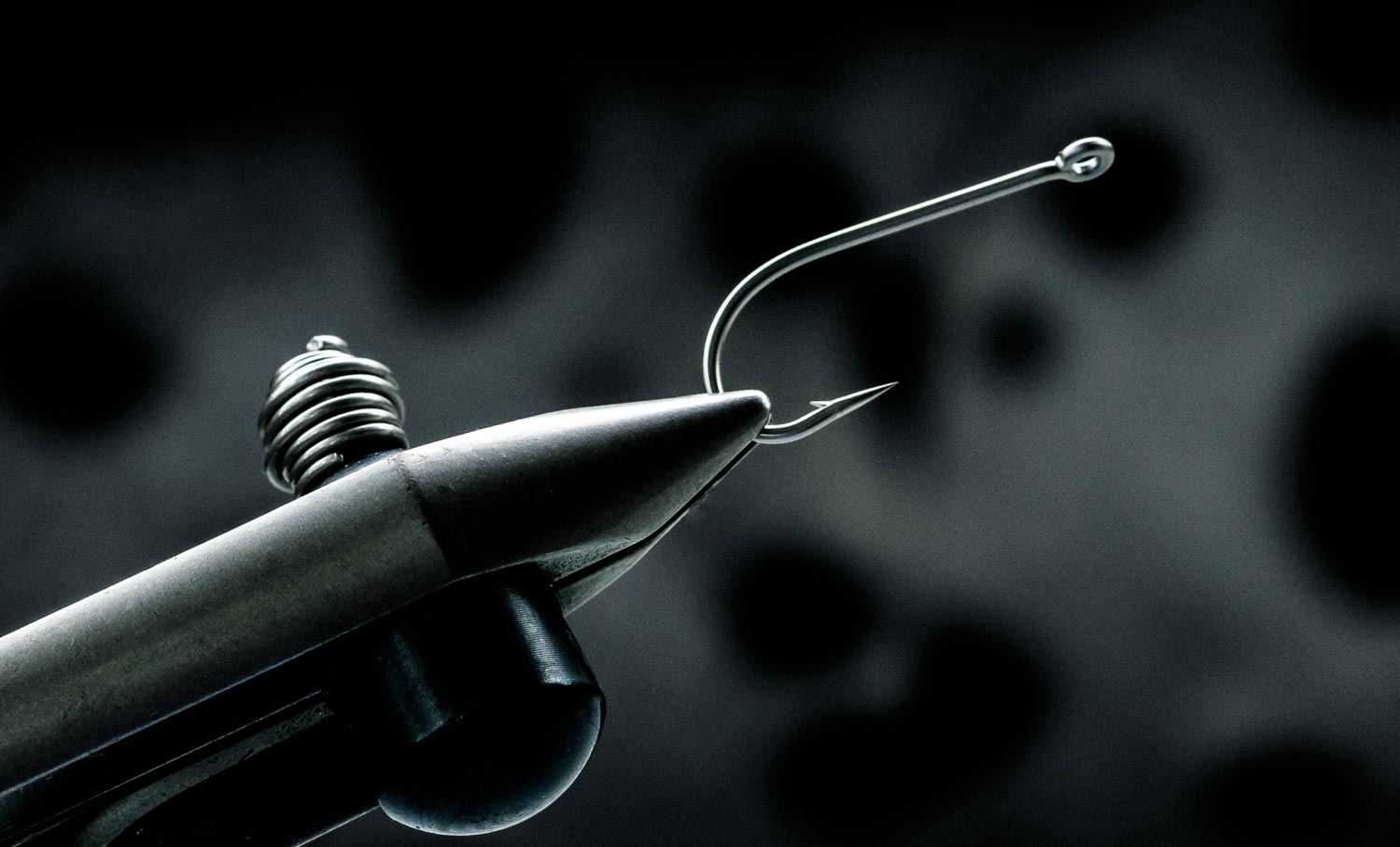
By Justin Pickett
Being a consistent fly tying machine can sometimes be challenging.
Especially if you plan to tie in the interest of making some extra spending cash, you need to stay consistent and efficient. When it comes to consistency, you’ve got to be able to stick to your recipes day in and day out, and not wander off due to complacency, or from just not having a golden standard to tie from. One of the things that I have done over the years that has helped me tie consistent flies is to simply use my vise. Our vises are more than just hook holding apparatuses. They hold materials, flies, tools, lights, but something else they do (an unadvertised feature) can be even more beneficial while sitting at the tying desk.
Aside from providing the platform from which we tie flies, a vise can also provide measurements and points of reference.
When I tie, I always place the hook in the vise the same way, whether it is a 2/0 or a #20. When I lay the hook in the vise I make sure to have the tip of the barb just barely inside the very tip of the vise jaw. For barbless hooks, I place the hook point even with the tip of the jaw, completely covering the bottom bend of the hook. This gives me a consistent starting point before I lay the first wraps of thread. When it comes to tails, wings, legs, foul guards, weed guards and just about any other material that needs to be measured or trimmed, I have numerous angles, screws, and joints along the vise that I can use as landmarks to ensure that I have the correct length, or that I’m placing a material in the right place.
These are all things that you’ll
Read More »Stealth for Trout- Don’t Break the Sound Barrier
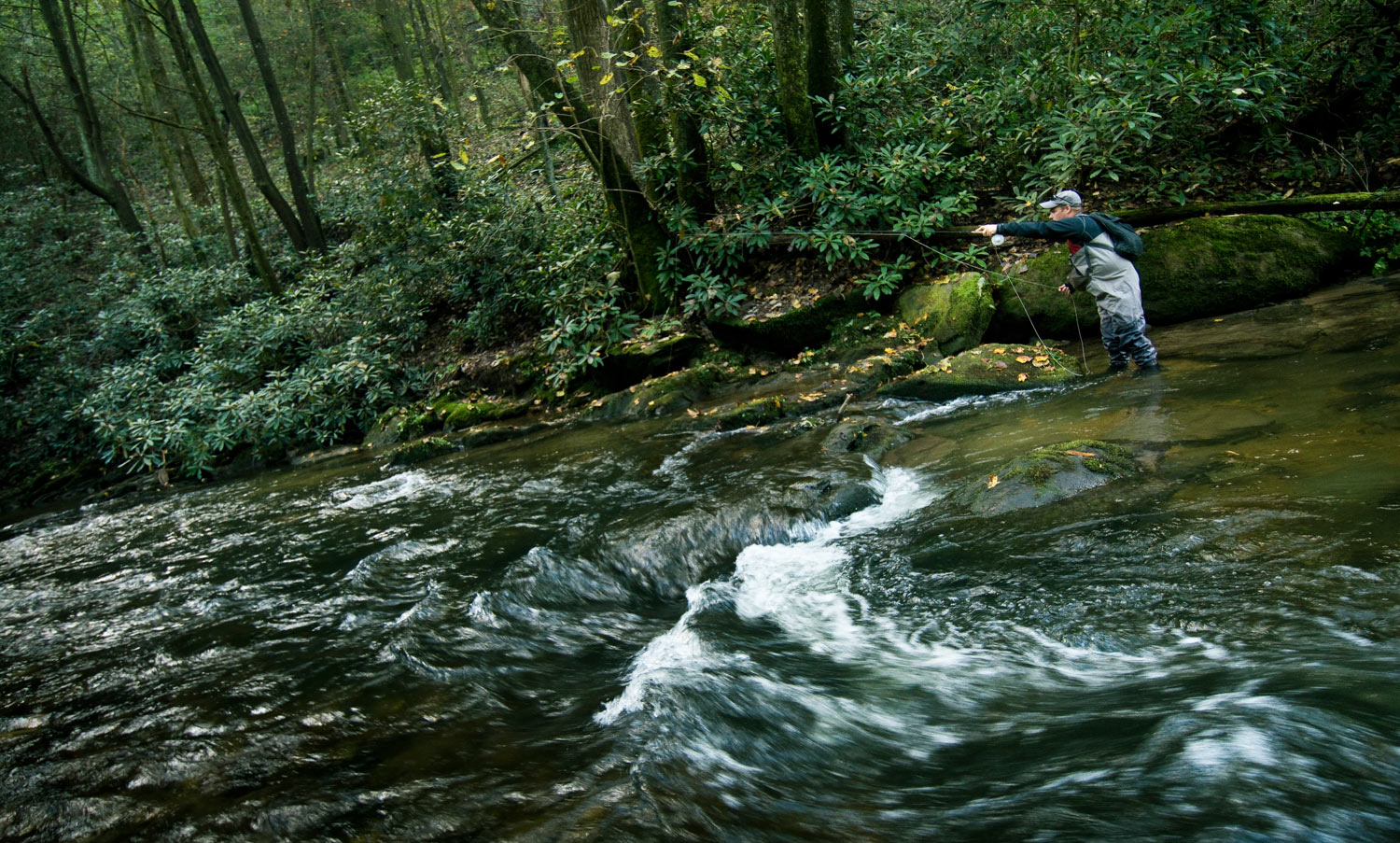
I’m always looking for ways to get an edge while trout fishing.
Trout are incredibly sensitive to their environment. They are constantly on the lookout for both food and predators. In an instant they can go from feeding on mayflies to fleeing an otter or eagle. Or you.
Insert yourself, the angler, into the happy world of the trout. Here you come, hulking four to six feet above the water, pushing a bow wave, splashing water all over the place, feet grinding the gravel, and it’s a surprise that trout ever come back out to feed. You and I would need therapy after such an encounter.
IMHO anglers do not pay enough attention to the effect of sound on trout, and I can’t tell you the number of times I’ve seen anglers wade directly into a hole or run with the fish and proceed to put them down before they ever make a cast. Here is a tip to help you out.
KEEP SOME SORT OF “SOUND BARRIER” BETWEEN YOU AND THE FISH.
The Smoky Mountain streams I live near offer many such barriers. They are mostly
Read More »Reece’s Masterpiece Midge
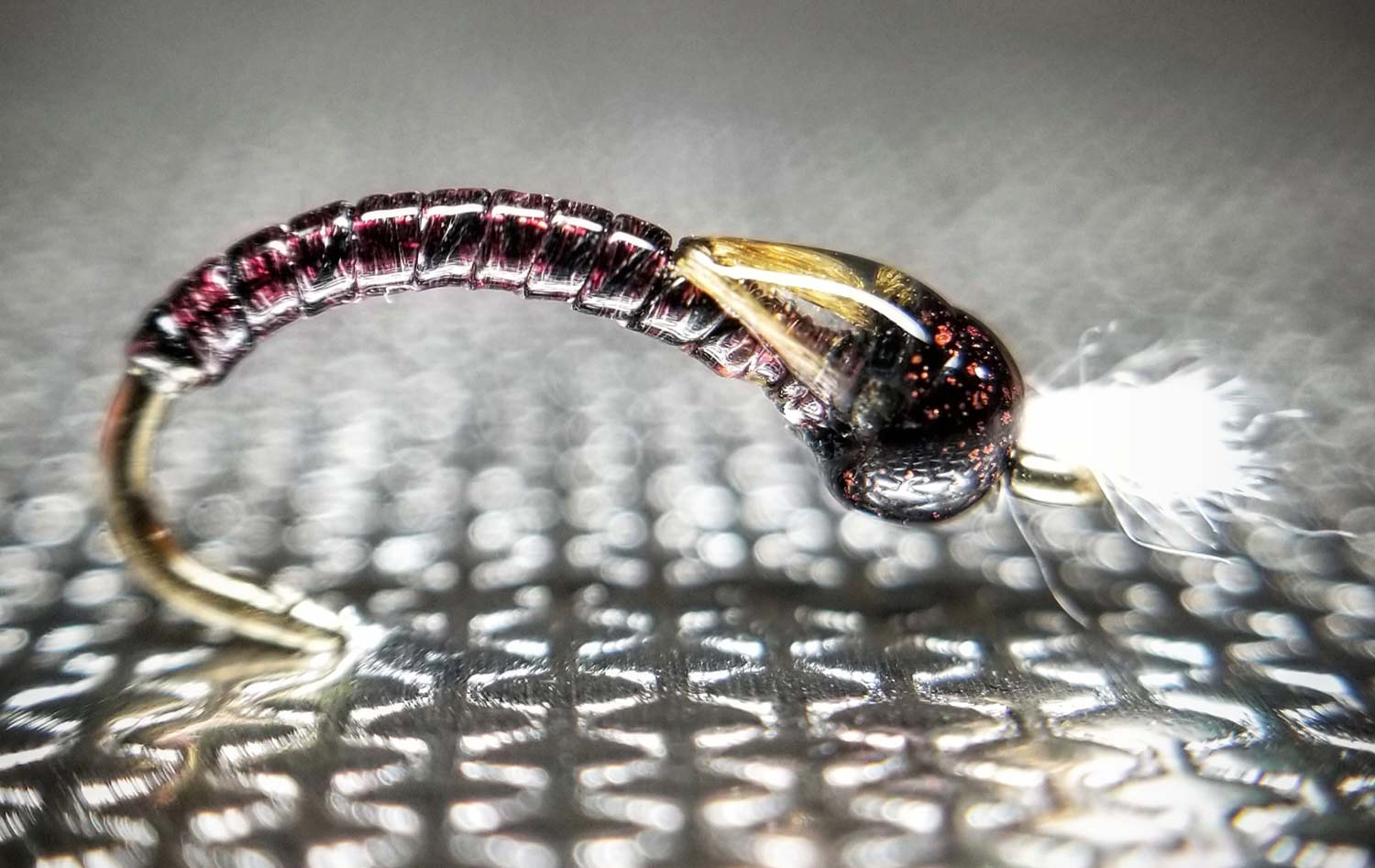
By Bob Reece
From still to moving waters, members of the Chironomidae family abound.
As a result of this, they are frequently found on the dietary menu of trout. Having a diverse selection of imitations for this family of insects can greatly increase your chances of connecting with fish.
Natural Chironomids consistently display a degree of translucency. In an effort to imitate this element, the outer body of the Masterpiece Midge is constructed of clear stretch tubing. In an underlying foundation, Veevus Body Quil is laid down to provide color and a slight degree of reflectivity. The combination of these two materials creates a powerful subsurface effect. When submerged, the clear tubing catches light and returns a glowing mottled coloration reflected from the body quil. In addition to this, the perfect segmentation created by the tubing, accurately imitates the natural while providing a high level of durability.
The wing buds are a prominent feature of a Chironomidae Pupae. In imitation of this, MFC Sexi Floss is applied. This spandex material has a slight degree of reflectivity. Coating this element with UV clear coat creates an accurately translucent and durable imitation.
The bead on this pattern is one size below what is recommended for the hook. This creates
Read More »Tie the Chard Choker Permit Fly
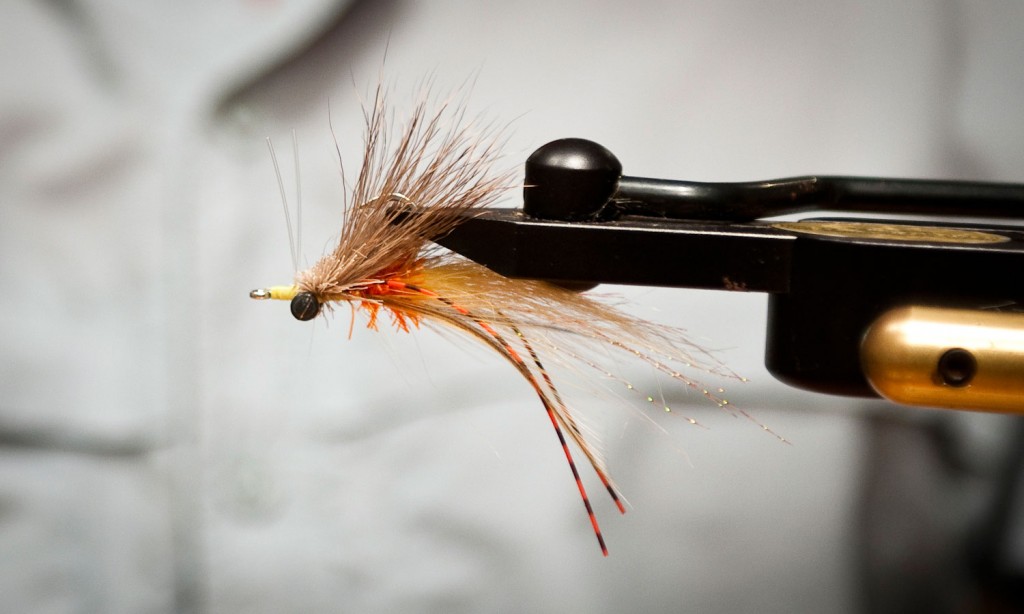
PERMIT FISHING IS AS EXACTING AS IT GETS.
When asked to list the top ten reasons permit will refuse a fly, Bruce Chard listed, among other things: a butterfly in Indonesia flapped its wings and because that’s what they do.
Getting a shot a a tailing permit is a test of an anglers resolve. Everything must be done perfectly. Even if everything is done perfectly there’s no guarantee of an eat. The first thing the angler must do is choose the right fly.
For tailing permit in shallow water the Chard Choker is a good choice. Check out the video to learn to tie this killer permit fly.
Read More »Swinging Steelhead Flies for Trout
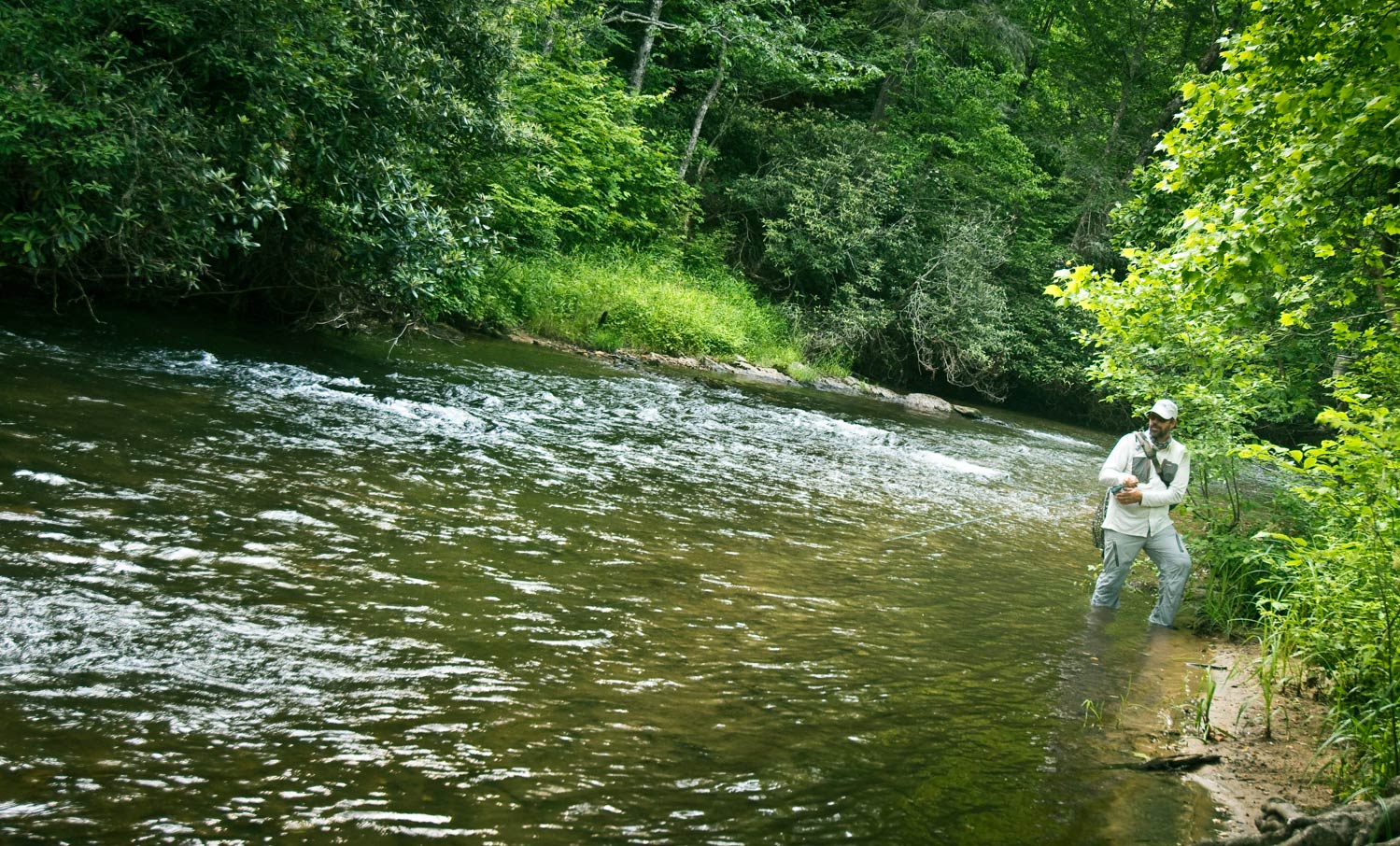
WANT TO GO STEELHEADING BUT THERE ARE NO STEELHEAD WHERE YOU LIVE?
Think about scaling down. The same flies and techniques that we use for steelhead will catch plenty of trout. And why not? Steelhead are just big sea-run trout and they have the same common instinct as their land-locked cousins.
I find myself fishing light switch rods for trout a lot these days. They are great versatile rods and I use them, not just because they’re effective, but because I enjoy it. One day, when I was swinging a small streamer with my 11′ 3″ three weight it struck me that was doing all the same things I did when steelheading. I went home and tied some of Hickman’s fish tacos in olive, size eight.
_DSC6030I caught a lot of fish on those flies but I thought I could take it further. I was tying flies for an upcoming trip to the Deschutes and I threw a couple of them in my trout box. My buddy Dan and I went fishing and devoted the whole afternoon to swinging steelhead flies. The results were awesome!
We caught a bunch of really nice fish but that’s not all.
Read More »Making A 100 Foot Cast Is Easier Than You Think
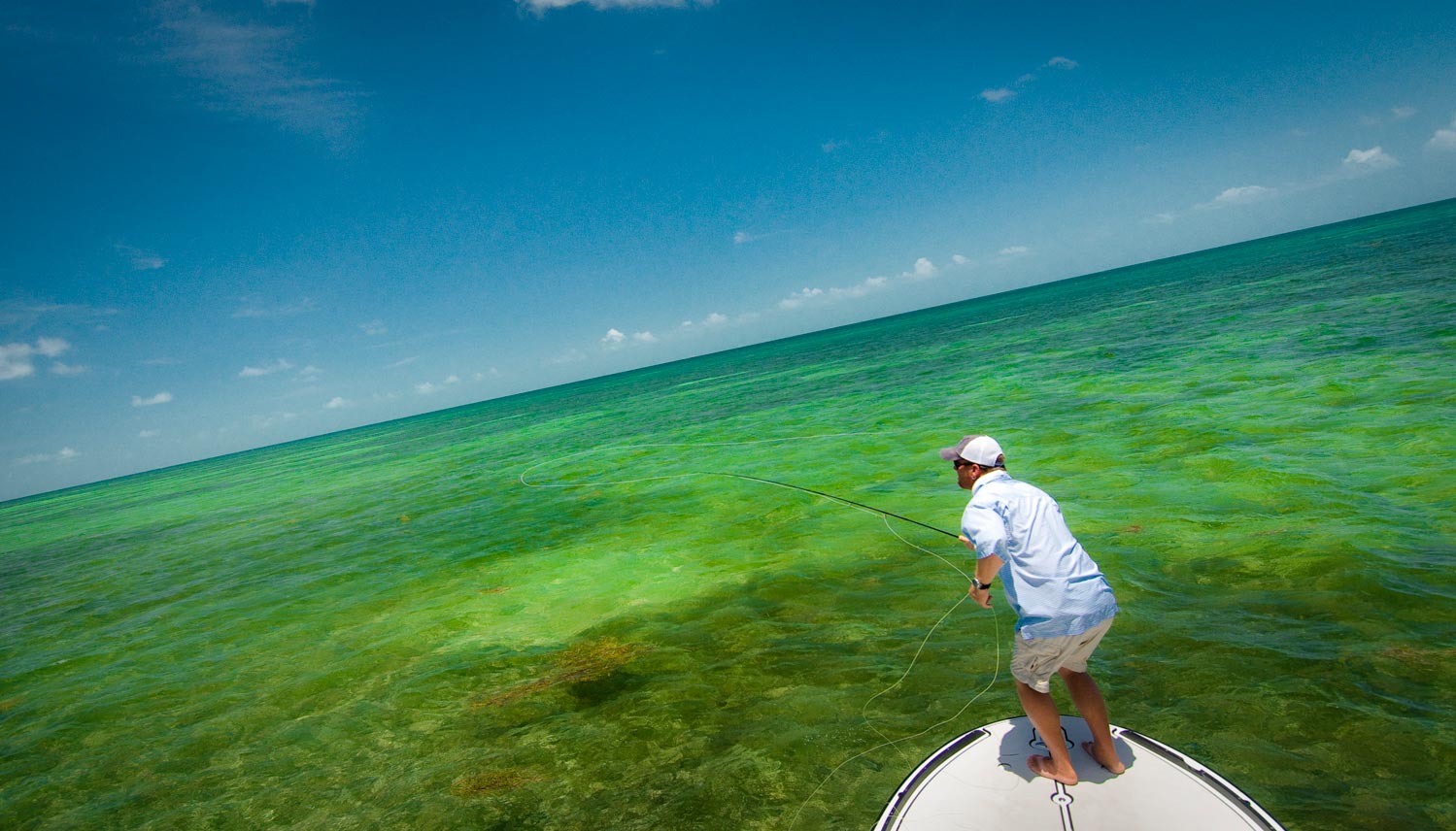
Casting a fly 100 feet is not an unattainable goal.
In response to my review of the T&T Solar a reader asked, “This may be a dumb question, but how do you get 100′ of line out on a cast?” It’s not a dumb question and it deserves a detailed answer.
It’s easier than you think. That doesn’t mean that you will read this article and instantly be able to do it. My point is more that most folks who are trying to make long cast are trying too hard and that’s a lot of their problem. Distance casting is about timing and technique, not power.
and with a little practice a hundred feet is perfectly doable.
You will have to excuse me here, but if I don’t make a few qualifying statements I’ll be called everything but the son of God in the comments section.
First, and likely most important, you don’t have to make a long cast to catch fish. Even in saltwater an accurate forty-foot cast is more important than a long bomb. In trout fishing the long cast is almost non-existent and can even be a liability. That said, there are times when a long cast will add to your catch. There is also a lot to be said for the confidence you gain from mastering the long cast. Making a long cast requires good technique and there’s no downside to being a better caster.
Secondly, let’s not get hung up on the number. Although I can cast 100 feet when everything goes right, 90 feet is a much better working distance for me. I can make that cast with a greater degree of accuracy and consistency. Both are important and your number for accuracy and consistency is what’s important. It will always be a little less than your maximum distance. For the sake of discussion let’s just say “long casts” and define that as anything over 70 feet.
So, if you are still interested in making long casts read on and if not, move on and spare us your dissertation on Euro Nymphing.
The Price of Admission
Read More »Thank You God for the Terrestrial Season
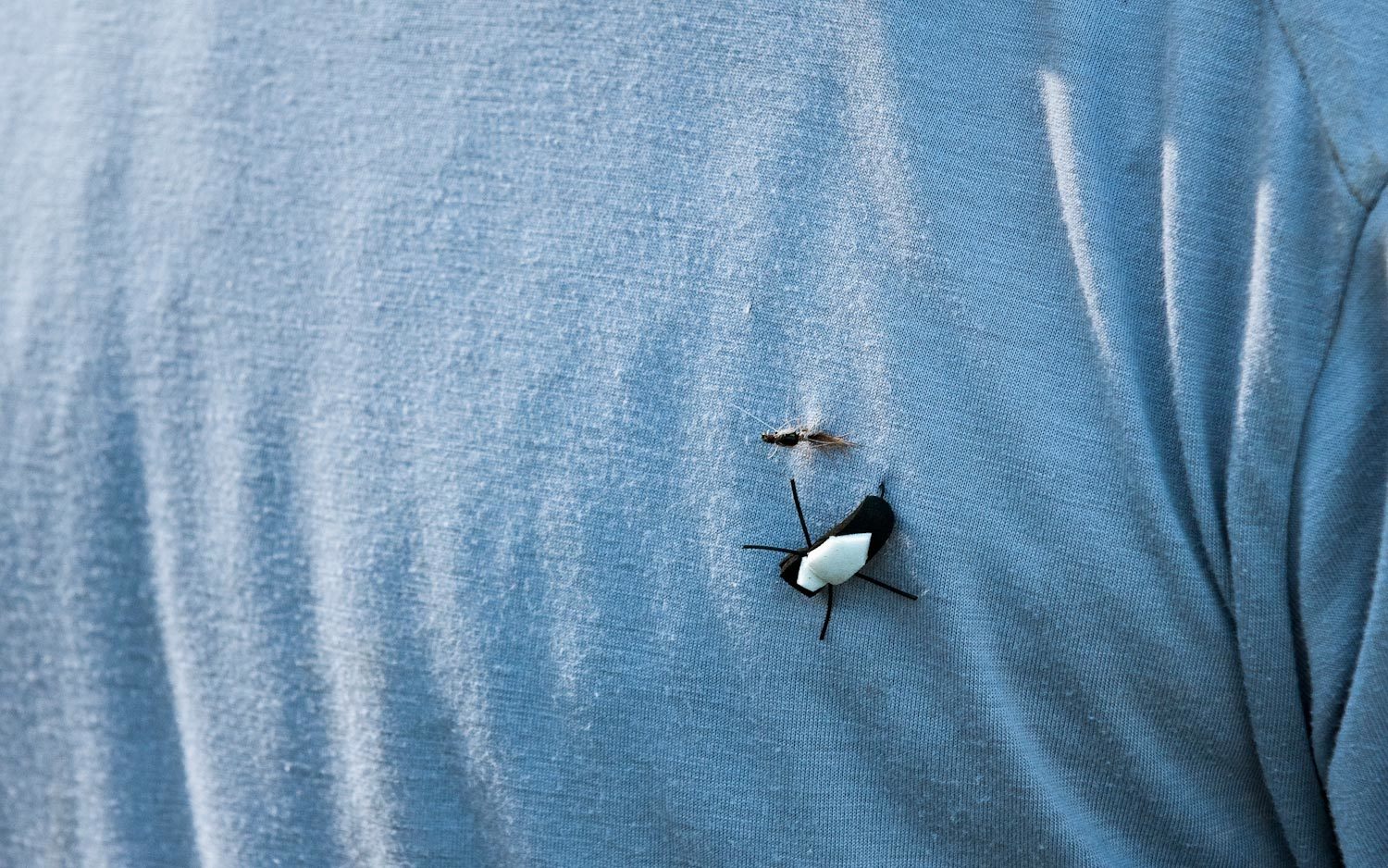
bout this time every year, when I’m starting to get run down from guiding, the terrestrial season arrives, and I’m blessed with a second wind.
I’m always astonished at how the presence of terrestrials can make my familiar trout waters seem so fresh and new to me. Even after I’ve already spent hundreds of hours during the season drifting flies through the same riffles, runs and pools. Every day, I find myself more excited about fishing than the last, despite it being one of my busiest times of the year guiding. Thank God for the terrestrial season. I tip my hat to the creator, for he sure did a fine job of planning out the life cycle and timing of the terrestrial season. Yep, life is grand for the fly fisherman when the terrestrials are out. The water and air temperatures (at least where I live) are usually warm enough to leave those stinky waders at home, and the longer days allow us the luxury of staying on the water for a few extra hours.
Is it just me, or do trout seem to have the same look in their eyes as we do during the terrestrial season, pure addiction. I love the fact that it’s not the end of the world if we forget our strike indicators or split shot when the terrestrials are out. The trout often rise
Read More »Focus and Determination Make It Happen
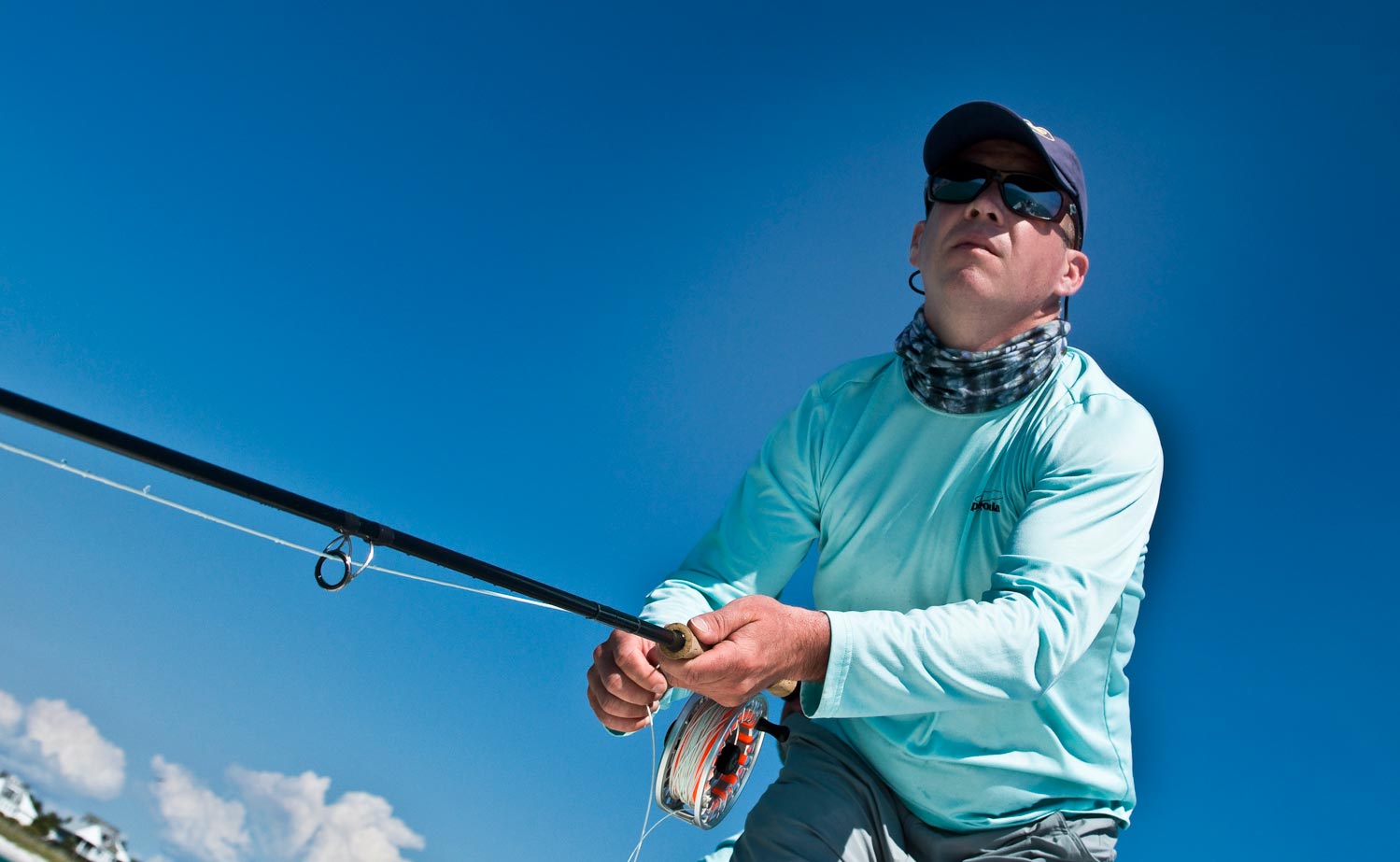
WHEN WAS THE LAST TIME YOU STARTED YOUR DAY WITH A KICK IN THE NUTS?
That’s exactly what happened to Mike Pyle the other day. For those of you who haven’t been following, I’ll give you a little background. Mike Pyle is a professional UFC fighter, fly fishing ninja and founder of Fish On Energy. G&G recently became one of his sponsors and it’s been really exciting being part of the team.
Mike had a tough fight on the card. Squaring off against a challenger eleven years younger than himself. I was fired up when I turned on Fox Sports and saw Mike with the flaming fish hook on his shorts. Mike’s technical fighting style was serving him well when, early in the first round, he took a knee in the groin. His young opponent was unbelievably strong and a good wrestler. It was clear that Mike had his work cut out for him.
Mike took a beating for most of that fight. It was only his skill and technique that kept him in the game. In spite of physical pain and a powerful opponent, he stayed focused and determined and in the last round turned the tables. The young challenger lost focus for an instant and Mike was there with the presence of mind to take advantage of it. Mike got him in a submission hold and almost ended the fight there.
In the end, his opponent broke the hold and won by a narrow decision. Regardless, I was impressed by Mike’s performance and proud to have my logo on his shorts. What’s more, I think he fought like an angler and there’s a lesson there for all of us.
The day after the fight I was telling Mike about a tarpon trip I went on recently. It felt a lot like that fight. Like a kick in the nuts in fact. Six of us went to fish Bocca Grande and found some of the most frustrating tarpon fishing I’ve ever encountered. We saw hundreds of fish but none that would eat.
The conditions were challenging. Very windy and, as we were fishing on the beach in heavy swells, it was a lot like bull riding. Waves crashing, some times knee high, over the bow. Time after time, I fought the wind and waves to made textbook presentations, only to see them refused. These fish were lock jawed and I couldn’t buy an eat.
After three days of that, it’s easy to lose your focus. To give up. To expect every fish not to eat. The funny thing about fly fishing, and a fight for that matter, is you tend to get what you expect. If you embrace the futility of the situation, your confidence is gone and it starts to show. It shows in sloppy presentations, half-hearted retrieve and lack of focus. I can tell you this from experience. If you don’t believe it’s going to happen, it isn’t.
You have to know there is a fish out there for you. You have to believe that every fish you see could be that fish. Every time you cast, you have to believe it’s going to happen. If you don’t believe in it, the fish damned sure will not.
Near the end of day three
Read More »